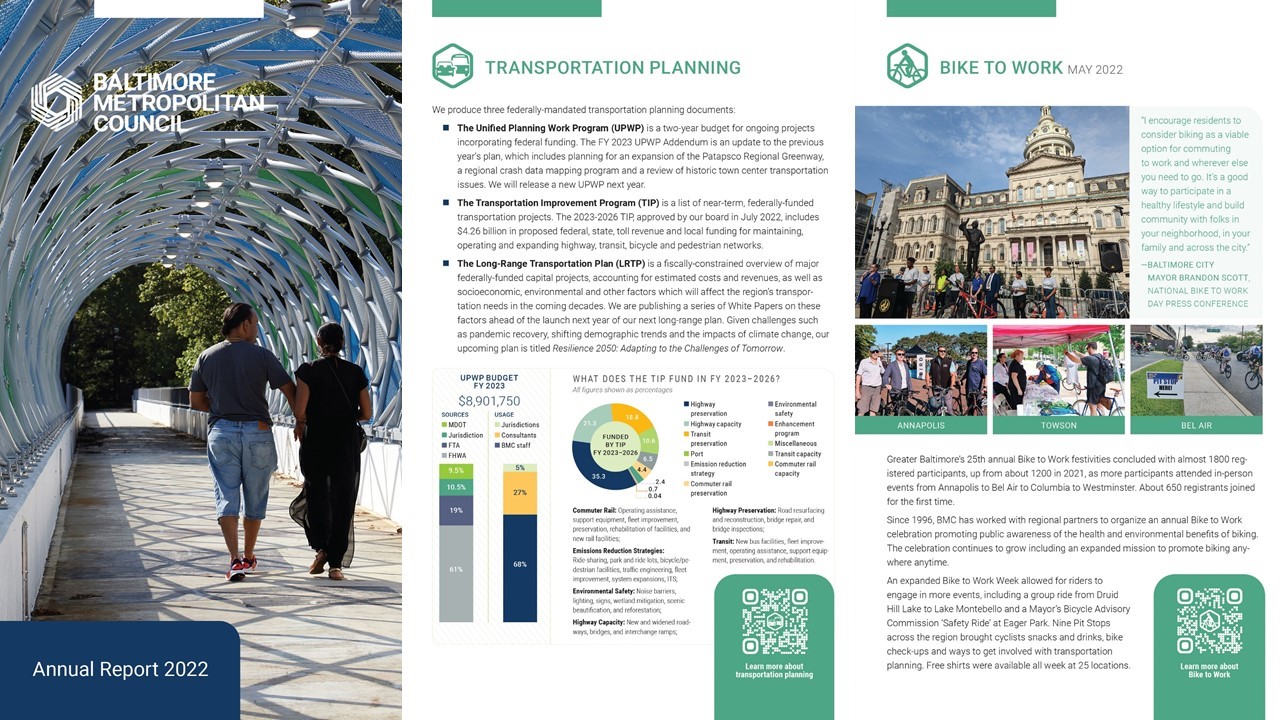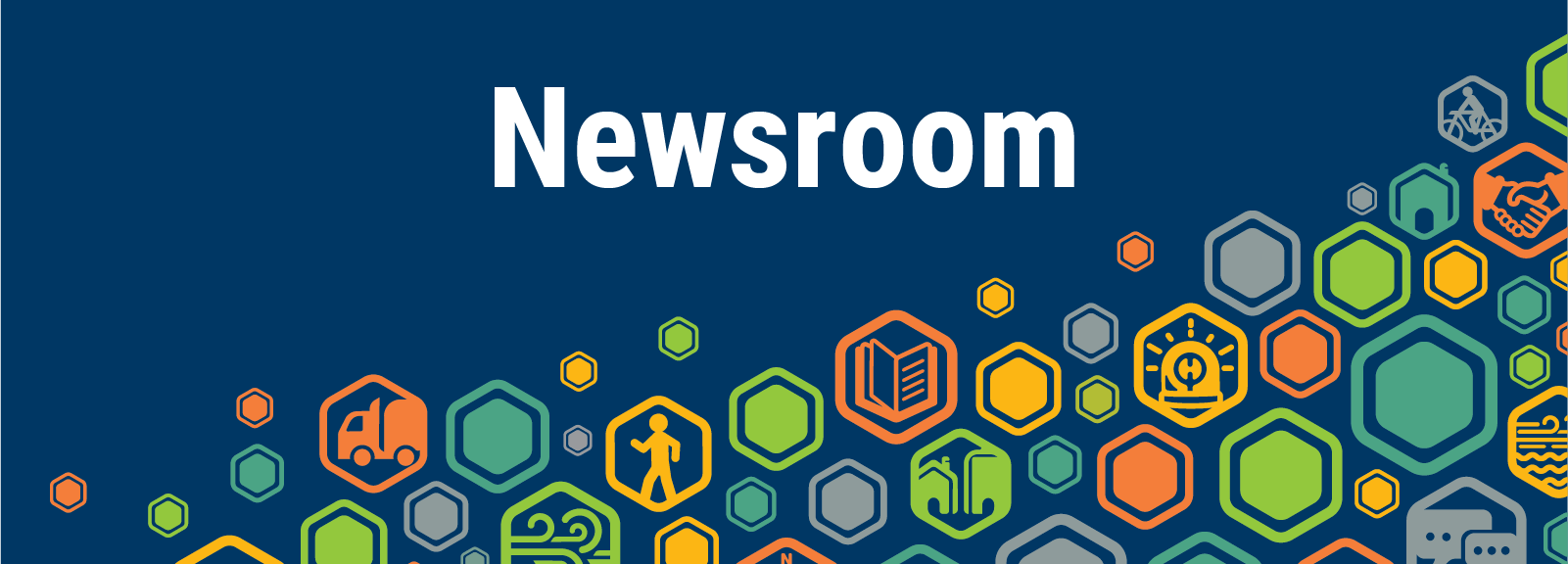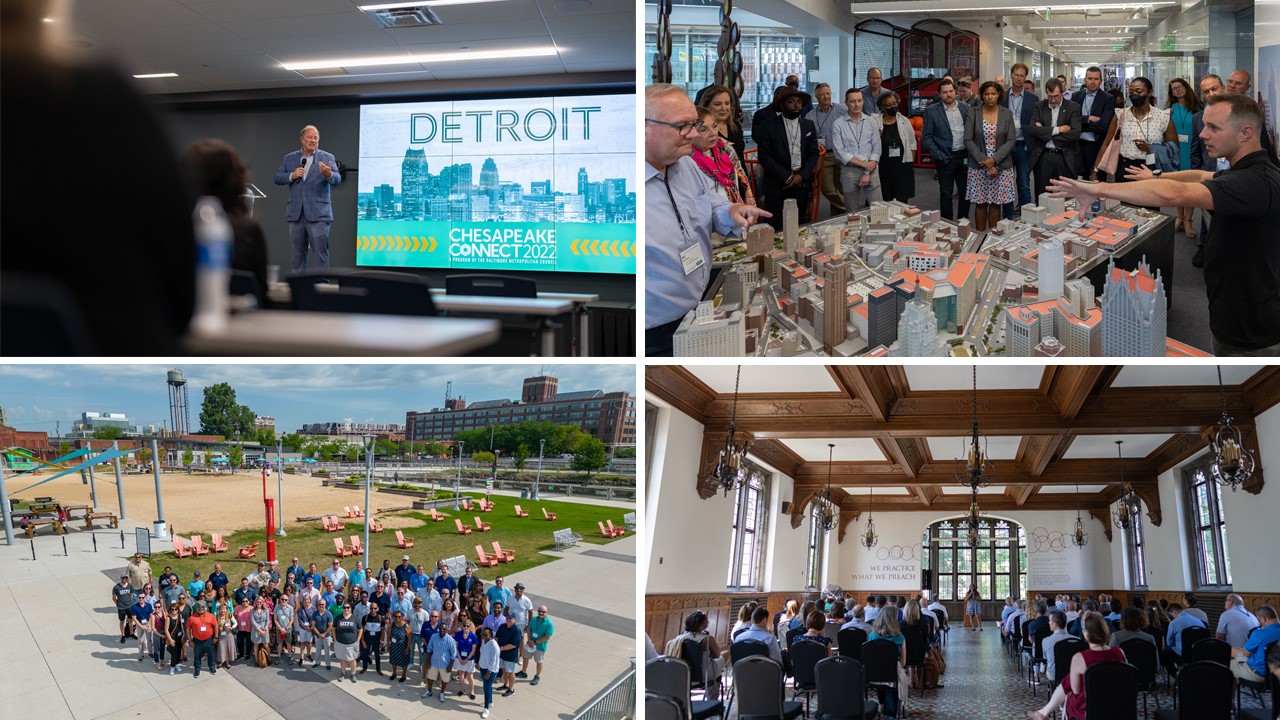BMC publica el informe anual 2022
BALTIMORE, MD (jueves, 3 de noviembre de 2022) – El Consejo Metropolitano de Baltimore (BMC), el consejo de gobiernos y la organización de planificación metropolitana de la región de Baltimore, publicó su Informe anual de 2022. El informe incluye el estado financiero auditado de la agencia y los aspectos más destacados de los principales planes y proyectos del año fiscal anterior.
“Nos estamos volviendo a conectar, sanando y prosperando después de un tiempo desafiante y fragmentado”, dice el director ejecutivo de BMC, Mike Kelly. “En BMC estamos orgullosos de participar en este trabajo y emocionados de aprovechar nuestro impulso a medida que miramos hacia el futuro”.

Haga clic aquí para ver el Informe Anual 2022.
En el último año, BMC supervisó el desarrollo de un Programa de mejora del transporte de $ 4260 millones y un plan a largo plazo de Resiliencia 2050. El personal creó herramientas para ayudar en los esfuerzos de planificación local, incluidos los pronósticos de crecimiento de la población y el empleo, los objetivos de rendimiento de la seguridad vial y una guía de recursos sobre el cambio climático. El Programa de Vales Basado en Proyectos Regionales de BMC ayudó a más de 30 familias a encontrar viviendas asequibles, y la Junta de Energía del Comité de Compras Cooperativas Regionales de Baltimore ahorró un récord de $32.5 millones en electricidad.
A medida que la región se recupera de la pandemia de COVID-19, BMC ha regresado cada vez más a los programas en persona. Después de cancelar un viaje a Minneapolis programado para 2020, BMC llevó a un grupo de líderes del área de Baltimore a Filadelfia para su cuarto viaje a Chesapeake Connect. Unos meses más tarde, casi 1800 participantes se unieron a eventos presenciales en toda la región para la 25.ª celebración anual Bike to Work del área metropolitana de Baltimore.
Junto con el Informe Anual 2022, BMC también está lanzando un boletín informativo trimestral para mantener a los lectores informados sobre las actividades de la agencia. Haga clic aquí para registrarte.
###
El Consejo Metropolitano de Baltimore (BMC) trabaja en colaboración con los principales funcionarios electos de la región para crear iniciativas para mejorar nuestra calidad de vida y vitalidad económica. BMC, como el consejo de gobiernos de la región de Baltimore, alberga la Junta Regional de Transporte de Baltimore (BRTB), la organización federal de planificación metropolitana (MPO), y apoya al gobierno local mediante la coordinación de esfuerzos en una variedad de áreas de política que incluyen preparación para emergencias, vivienda, compras cooperativas. , planificación ambiental y desarrollo de la fuerza laboral.
La junta directiva de BMC incluye a los ejecutivos de los condados de Anne Arundel, Baltimore, Harford y Howard, el alcalde de la ciudad de Baltimore, miembro de las juntas de comisionados del condado de Carroll y del condado de Queen Anne, miembro del Senado del estado de Maryland, miembro de la Cámara de Delegados de Maryland, y un gobernador designado del sector privado.


BALTIMORE, MD (Thursday, August 18, 2022) – The Baltimore Metropolitan Council (BMC) will convene a Transit Governance and Funding Workgroup to identify ways to improve transit governance and funding in the Baltimore region.
Established by BMC’s Board of Directors at its July 15th meeting, the workgroup will be chaired by BMC board member, Delegate Tony Bridges. "Moving forward it is critical that our transit system work for residents and businesses throughout Baltimore," said Delegate Bridges. "I'm thankful to my fellow BMC board members for their leadership and to the members of the workgroup for their commitment to the issue."
The appointed members of the workgroup include:
- Tony Bridges, Maryland State Delegate, Baltimore City, District 41
- Dr. Celeste Chavis, Associate Professor of Transportation and Urban Infrastructure Studies, Interim Associate Dean for Undergraduate Studies, Morgan State University’s Clarence M. Mitchell, Jr. School of Engineering
- Andrew Gena, Director of Strategic Research, Amalgamated Transit Union AFL-CIO/CLC
- Tasha Gresham-James, Executive Director, Dundalk Renaissance
- Ron Hartman, Senior Consultant, WSP USA
- Jon Laria, Managing Partner, Ballard Spahr
- Michael McMillan, President & Business Agent, Amalgamated Transit Union Local 1300
- Tony Scott, Executive Director, Southwest Partnership
- Samuel Snead, Director, Anne Arundel County Department of Transportation
- Aaron Tomarchio, Executive Vice President of Corporate Affairs, Tradepoint Atlantic
- Adrea Turner, Chief of Staff, Urban Institute
- D’Andrea Walker, Acting Director, Baltimore County Department of Public Works & Transportation
- Mary Washington, Maryland State Senator, Baltimore City, District 43
“Public transportation plays an essential role in the advancement of people, businesses, the environment and overall economy of a city and a region,” said Baltimore Mayor Brandon M. Scott. “As our local economy emerges from the pandemic, we will need to adequately advocate for and invest in an inclusive transit system that truly connects all of our residents to educational and employment opportunities to drive economic growth for communities throughout Baltimore."
The workgroup has two objectives. First, the workgroup will prioritize one or more governance models identified in the Baltimore Regional Transportation Board’s 2021 Baltimore Regional Transit Governance and Funding Study. The 2021 study researched and identified five potential governance and funding structures for the region’s transit services, as well as a sixth option of maintaining the status quo. The workgroup will review options detailed in the 2021 study and make a formal recommendation to the BMC Board of Directors, Maryland General Assembly, and Governor.
"The assembled transit, business and thought leaders are experts in their fields," said Baltimore County Executive John Olszewski, Jr. "I look forward to hearing the recommendations so we can work with the General Assembly and next Governor to provide meaningful and impactful transportation solutions for the Baltimore region."
Additionally, the workgroup will review funding associated with the Locally Operated Transit Systems (LOTS) program and develop options for increased equity and transparency in the distribution of those funds.
The Baltimore Regional Transit Governance and Funding Workgroup will meet on the first Friday of every month through the end of the year. Meetings will be held at the Baltimore Metropolitan Council’s office and will be open to members of the public. The first meeting will be on September 2, 2022. Click here to view the workgroup's opening presentation.
“This workgroup is a necessary step toward establishing a high functioning and more equitable transit system for the Baltimore region,” said Mike Kelly, executive director of the Baltimore Metropolitan Council. “BMC has taken a thoughtful and diligent approach in analyzing the region’s transit system and I’m pleased to see the issue of local input and decision-making is becoming central to the conversation.”
###
The Baltimore Metropolitan Council (BMC) works collaboratively with the chief elected officials in the region to create initiatives to improve our quality of life and economic vitality. BMC, as the Baltimore region’s council of governments, hosts the Baltimore Regional Transportation Board (BRTB), the federal metropolitan planning organization (MPO), and supports local government by coordinating efforts in a range of policy areas including emergency preparedness, housing, cooperative purchasing, environmental planning and workforce development.
BMC’s Board of Directors includes the executives of Anne Arundel, Baltimore, Harford and Howard counties, the mayor of the City of Baltimore, a member of the Carroll County and Queen Anne’s County boards of commissioners, a member of the Maryland State Senate, a member of the Maryland House of Delegates, and a gubernatorial appointee from the private sector.

BMC Brings Local Leaders to Detroit, MI for Chesapeake Connect 2022
BALTIMORE, MD (Wednesday, July 26, 2022) - The Baltimore Metropolitan Council (BMC) led its annual Chesapeake Connect trip to Detroit, Michigan from Wednesday, July 20 to Friday, July 22, bringing together leaders from across greater Baltimore to connect, reflect and learn from the experiences of a peer region.
Over 60 government, private sector and nonprofit leaders joined BMC in Detroit, with a program focused on unpacking the profound impact of Detroit’s 2013 municipal bankruptcy. Through site visits and discussions with local community leaders, BMC sought to curate an effective exploration of the innovative developments reinvigorating a great American city.

Motor City, as Detroit became known due to its place as a global hub for auto manufacturing, shares many of the challenges facing Charm City, including a declining population, historic under-investment and barriers to building wealth in communities of color. Detroit has bright minds implementing brilliant ideas to counter these challenges, and the Chesapeake Connect trip posed the question: how can we bolster similar ideas in and around Baltimore?
The trip kicked off with a visit to the Union Carpenters and Millwrights Skilled Training Center, where participants heard from Detroit Mayor Mike Duggan about his efforts to guide the city out of bankruptcy. Later that day, a tour of downtown concluded at One Campus Martius, where participants dined with the Rock Family of Companies and learned about their historic corporate and private investment in the city.
On day two, participants got a close-up view of development in Detroit’s neighborhoods, starting with the cradle-to-career campus opening at Marygrove Conservancy. That afternoon, small groups broke out to explore four industry hubs across the city. That evening, participants reconvened for dinner in the enclave of Hamtramck, hearing from Mayor Amer Ghalib and members of what is believed to be the country’s first all-Muslim city council.
For the final day, participants focused on open spaces and public waterfront development, touring the downtown Capitol Park and a five-mile pedestrian stretch of the Detroit Riverfront before a closing lunch at the Michigan Department of Natural Resources Outdoor Adventure Center.
For more details about the trip, see BMC’s Chesapeake Connect 2022 story map or peruse the Chesapeake Connect 2022 Program.
Participants will be invited to join a Chesapeake Re-Connect wrap-up event to encourage a continuing dialogue about the innovations and development strategies observed in Detroit.
Previous Chesapeake Connect trips have brought leaders from the Baltimore region together in Philadelphia, Nashville, New Orleans and Cleveland. BMC has already begun planning the Chesapeake Connect 2023 trip and will announce the destination and dates early next year.
Chesapeake Connect 2022 would not have been possible without the support of sponsors, including Mercy Medical Center, 28 Walker, BGE, Exelon, Hartman Executive Advisors, the Maryland Institute College of Art, Southway Builders, Tradepoint Atlantic, the Baltimore Community Foundation, Design Collective, Loyola University Maryland, Morris & Ritchie Associates, Ballard Spahr, the Baltimore Development Corporation, Chase Brexton Health Care, Gordian Energy Systems, Howard Hughes, Park Heights Renaissance, University of Maryland Baltimore, the University of Maryland Medical System, Web Connection, and the Annie E. Casey Foundation.
###

BALTIMORE, MD (Friday, January 21, 2022) – The Baltimore Metropolitan Council (BMC) hosted its virtual board of directors meeting at 9 a.m. on Friday, January 21, 2022, unanimously approving Harford County Executive Barry Glassman as its 2022 chair, and Howard County Executive, Calvin Ball, as its vice-chair.
Throughout his 30 years in public service, Barry Glassman has been recognized for outstanding character and leadership. He has been a BMC board member since 2014, and served as chair in 2016. He will serve as BMC board chair for a second time through January 2023.
“It is a great honor to chair the board of the Baltimore Metropolitan Council,” said County Executive Glassman. “Harford County is an integral piece of the puzzle that comprises greater Baltimore and I look forward to working with the other jurisdictional leaders to leverage our resources for the region.”
Mike Kelly, BMC Executive Director says “County Executive Glassman has been an instrumental asset to the BMC board for many years. His insight and leadership is invaluable to the progress of our organization and the region at large. We look forward to what is to come as we continue to serve in the region’s recovery.”
BMC also welcomes Howard County Executive Calvin Ball as vice-chair. He has been a BMC board member since 2018 and will serve as vice-chair through January 2023.
###
The Baltimore Metropolitan Council (BMC) works collaboratively with the chief elected officials in the region to create initiatives to improve our quality of life and economic vitality. BMC, as the Baltimore region’s council of governments, hosts the Baltimore Regional Transportation Board (BRTB), the federal metropolitan planning organization (MPO), and supports local government by coordinating efforts in a range of policy areas including emergency preparedness, housing, cooperative purchasing, environmental planning and workforce development.
BMC’s Board of Directors includes the executives of Anne Arundel, Baltimore, Harford and Howard counties, the mayor of the City of Baltimore, a member of the Carroll County and Queen Anne’s County boards of commissioners, a member of the Maryland State Senate, a member of the Maryland House of Delegates, and a gubernatorial appointee from the private sector.

The Baltimore Metropolitan Council led its annual Chesapeake Connect trip, in Philadelphia, Pennsylvania Wednesday, October 13 - Thursday, October 15, 2021. Chesapeake Connect brings leaders from across Baltimore region to a peer region for a three-day learning experience.
Over 60 leaders from across the region traveled by train from Baltimore Penn Station to Philadelphia’s 30th Street Station for the event. The agenda included presentations by Philadelphia leaders, tours of parks and public assets, and visits to non-profits and development sites with lessons for the Baltimore region.
The first day of the program focused on West Philadelphia’s University City, and the decades of cooperative investment by the City of Philadelphia and anchor institutions like the University of Pennsylvania and Drexel University. The day ended with a visit to the Enterprise Center, one of the most innovative and successful urban entrepreneurship centers in the entire country.
Our second day started with executive briefings on Philadelphia’s efforts to equitable invest in broadband access and aging city assets. Those briefings were followed by a tour of Dillworth Park, a privately managed park just outside of Philadelphia’s historic City Hall. The group then split into small groups to visit neighborhood development sites, groundbreaking urban trails, a nationally recognized public art effort and the Navy Yard, one of the largest redevelopment efforts on the east coast.
Our final day in Philadelphia began with a discussion of regionalism with leaders from the Delaware Valley Regional Planning Commission and the Southeast Pennsylvania Transportation Authority. The program closed with a tour of FDR Park, Philadelphia’s only Olmstead park that is currently in the midst of a strategic redesign to better meet the needs of a growing and diverse immigrant community in South Philadelphia.
The City of Brotherly Love, shares many of the same strengths and challenges of the Baltimore Metropolitan area. Both places boast of vibrant cultural and university districts, some of the world’s leading research institutions and balance of urban living with attractive and desirable suburban communities.
However, both places struggle with the socio-economic impacts of redlining, a crisis of substance abuse, and deep rooted economic, health, and technology based disparities made clearer by the pandemic.
Like Baltimore, Philadelphia is a city of neighborhoods, and every neighborhood story is unique. Over the three day event, attendees heard first hand from Philadelphia’s leaders and decision makers about the wins, pitfalls and works in progress that define the Philadelphia region.
The 2021 trip came after the necessary cancellation of the 2020 Chesapeake Connect trip, slated for Minneapolis, Minnesota. In response to the worldwide pandemic and out of an abundance of caution, BMC repurposed the trip into the “Chesapeake Connect Podcast.” The podcast focuses on a deeper exploration of the Baltimore region, through conversations with elected officials, non-profits, local companies and WYPR’s Tom Hall.
Past trips have included Nashville, TN, New Orleans, LA , and Cleveland, OH.
BMC will begin planning for Chesapeake Connect 2022 soon and will announce a destination and dates for the trip next spring. BMC is hopeful for another successful in person event.

BALTIMORE, MD (Wednesday, June 30, 2021) – The Baltimore Regional Transportation Board (BRTB) hosted its virtual meeting Tuesday, June 22 at 9 a.m. approving Anne Arundel County Executive Steuart Pittman as its FY 2022 chair, and Baltimore County Executive, John Olszewski Jr., as its vice-chair.
“The BRTB approaches transportation the way it should be done - from a regional perspective," Anne Arundel County Executive Steuart Pittman said. “It’s an honor to lead the organization in a time when regional leaders are aligned and the federal government is prepared to invest in public transportation.”
FY 2022 BRTB Vice Chair, County Executive Olszewski Jr., said “I’m thrilled to have the opportunity to serve as the vice-chair of the BRTB and look forward to working alongside our regional partners to continue building a stronger, more resilient, and forward-thinking region.
###
The Baltimore Metropolitan Council (BMC) works collaboratively with the chief elected officials in the region to create initiatives to improve the quality of life and economic vitality. BMC, as the Baltimore region’s council of governments, hosts the Baltimore Regional Transportation Board (BRTB), the federal metropolitan planning organization (MPO), and supports local government by coordinating efforts in a range of policy areas including emergency preparedness, housing, cooperative purchasing, environmental planning and workforce development.
BMC’s Board of Directors includes the executives of Anne Arundel, Baltimore, Harford and Howard counties, the mayor of the City of Baltimore, a member of the Carroll County and Queen Anne’s County boards of commissioners, a member of the Maryland State Senate, a member of the Maryland House of Delegates, and a gubernatorial appointee from the private sector.

BALTIMORE, MD (Monday, August 2, 2021) – Community members from around the Baltimore region are invited to take part in the Cycle September bicycle challenge from Wednesday, September 1 - Thursday, September 30. The Baltimore Metropolitan Council (BMC) and generous sponsors have partnered with Love to Ride to continue to bring the free online biking challenge and encouragement program to the region.
Community members can register now as individuals or as part of a workplace team at LovetoRide.net/CentralMD.
Bike rides to any location are eligible for Cycle September. Participants can consider biking to grab a bite to eat, to the store, the playground, to work or school, or around their neighborhood, while they earn points for every mile they ride, every day they ride, and every new person they encourage to ride throughout September.
Participants who register and ride during September have a chance to win both local and challenge-wide prizes including gear and apparel or $50 gift certificates to their favorite local bike shop. The event also features a local grand prize drawing of a $150 gift certificate to the winner’s local bike shop of choice.
The Love to Ride platform is an easy-to-run team building and staff engagement program that supports sustainability goals. Workplaces who participate can measure the collective impact of their organization by tracking how many miles and bike rides the team takes and how much CO2 (carbon dioxide) is saved during the month-long challenge. Riders can join a workplace team or start a new one to compete against other workplaces during the Cycle September challenge to see who can earn the most points in their size category for bragging rights and a framed winner’s certificate. Love to Ride calculates workplace points by adding up the individual points of each team member.
Love to Ride is supported by donations from generous sponsors: Anne Arundel County Commuter Crew, Baltimore City Department of Transportation, Rideshare of Baltimore and Carroll Counties, Clean Air Partners, Downtown Columbia Partnership, Harford County Public Library, Harford County Transit Link, Harford Commute Smart, Go Howard, Joe's Bike Shop, Maryland Department of Transportation, Race Pace Bicycles, Regional Transportation Agency of Central Maryland, and RK&K.
About Love to Ride Central MD
The Baltimore Metropolitan Council has partnered with Love to Ride to bring more fun, more community, and more inspiration to get more people biking. Love to Ride is a year round biking encouragement program where individuals can track the miles they bike and win incentive prizes, increasing the number of bike trips people take and encourages those who have not ridden in a while to get back on a bike. There are also two challenges per year, Bike Month in May and Cycle September, where workplaces compete to win in their respective size categories. LovetoRide.net/CentralMD.
###
The Baltimore Metropolitan Council (BMC) works collaboratively with the chief elected officials in the region to create initiatives to improve the quality of life and economic vitality. BMC, as the Baltimore region’s council of governments, hosts the Baltimore Regional Transportation Board (BRTB), the federal metropolitan planning organization (MPO), and supports local government by coordinating efforts in a range of policy areas including emergency preparedness, housing, cooperative purchasing, environmental planning and workforce development.
BMC’s Board of Directors includes the executives of Anne Arundel, Baltimore, Harford and Howard counties, the mayor of the City of Baltimore, a member of the Carroll County and Queen Anne’s County boards of commissioners, a member of the Maryland State Senate, a member of the Maryland House of Delegates, and a gubernatorial appointee from the private sector.

Bicyclists from around the Baltimore region are invited to take part in the 24th annual Bike to Work celebration scheduled for Monday, May 17- Sunday, May 23. Registration opens April 15 at biketoworkmd.com.
Organized by the Baltimore Metropolitan Council (BMC) and its member jurisdictions, Bike to Work Week is a socially-distanced cycling challenge to encourage commuting by bike. Riders qualify for free t-shirts, giveaways, and prizes, plus discover the advantages of a cleaner commuting option.
Participants who register for the event may ride any time during the week and pick up event shirts and other giveaways at participating bike shops throughout the region.
This year’s event, once again, includes a random prize drawing for gear and goodies as well as features a grand prize drawing for a new bike. All registered riders have a chance to win regional prizes. Free event t-shirts and goodie bags can be picked up at any time during the week, but are limited to the first 1,500 riders. Registration for Bike to Work Week 2021 is open through Saturday, May 22, at biketoworkmd.com.
To make Bike Month even more fun, BMC offers cyclists a free online cycling challenge and encouragement program called Love to Ride. This fun, friendly, and free competition between workplaces, clubs, and individuals uses prize drawings, leaderboards, and virtual networking to challenge users to get more people cycling – especially new riders. The program is year-round and features special prize challenges in May for Corporate Challenge participants.
Riders can register at lovetoride.net to earn points for every mile they ride, every day they ride, and every new person they encourage to ride. Individuals only have to ride for ten minutes anytime, anywhere – for fun, fitness, transportation, or even indoors – to be eligible for prizes and help their team climb the leaderboard.
Both Bike to Work Week and Love to Ride are supported by donations from generous sponsors. BMC member jurisdictions Anne Arundel, Baltimore, Carroll, Harford, Howard, and Queen Anne counties, along with Baltimore City serve as local organizers. Funding is provided in part by Clean Air Partners, Downtown Columbia Partnership, Harford Transit LINK, Commuter Crew, Regional Transportation Agency of Central Maryland, Harford Commute Smart, Race Pace Bicycles, the Maryland Department of Transportation, RK&K, Harford County Public Library, and Joe’s Bike Shop.
About Bike to Work Week
The Baltimore Metropolitan Council organizes an annual Bike to Work celebration in the region. Bike to Work Week is a campaign that celebrates bicycling as a healthy commuting option while promoting public awareness of its safety and environmental benefits. Bike to Work Week helps raise awareness of the rules of the road for drivers, pedestrians, and cyclists, and also highlights the need to improve bicycle facilities to improve safety.
About Love to Ride Central MD
The Baltimore Metropolitan Council has partnered with Love to Ride to bring more fun, more community, and more inspiration to get more people riding. Love to Ride is a biking encouragement website and app free to anyone who lives or works in the Central MD region.

[Baltimore, MD, March 4, 2021]
The Baltimore Metropolitan Council (BMC) applauds the release of a Request for Proposals (RFP) for a renewable power purchase agreement on behalf of local governments in the Baltimore region. Baltimore County, as chair of the Baltimore region’s Energy Board, will lead the RFP process.
The Baltimore Regional Cooperative Purchasing Committee (BRCPC) works with regional procurement officers from its eight county/city membership to aggregate purchasing volumes of like commodities and services to leverage government buying power. BMC hosts and provides staff support to the work of BRCPC and its subcommittees, including the Energy Board.
The Energy Board is responsible for energy cost management and procurement programs for both electric and natural gas supply on behalf of its 24 members (including local governments, community colleges, public schools, museums and libraries). The committee reviews and assesses energy market developments, including renewable energy, on an ongoing basis. The combined portfolios for the Energy Board’s 24 participants was $84.7 million in fiscal year 2020. The Energy Board purchases more than 1.62 million MWhs of electricity and 2.5 bcf in natural gas per year. The Board is the largest purchaser of electricity in the State of Maryland.
By working together, Energy Board members negotiate significant cost savings on energy purchases. When compared to Baltimore Gas and Electric’s (BGE’s) standard offer service (SOS) rates alternative during FY20 for non-hourly priced accounts, members saved $10.0 million on electricity. From the electric portfolio’s inception in June 2006 through June 30, 2020, the portfolio has generated savings of $173.8 million when compared to BGE’s non-hourly priced SOS rates.
“The cooperative energy purchasing facilitated through BMC and the Energy Board is a model of regional government collaboration,” said Carroll County Commissioner and BMC Board Chair Stephen Wantz. “We are proud of the nearly 15 years and millions in savings this group has achieved on behalf of taxpayers and we commend our partners in Baltimore County for leading the way in this next evolution of the committee’s work.”
For roughly two years, the Energy Board has explored leveraging their collective buying power to support new renewable energy development and secure additional renewable energy certificates in accordance with the State of Maryland’s goal of achieving 50 percent renewable energy by 2030. The RFP released today by Baltimore County represents months of analysis, discussion and deliberation by the participating organizations. The RFP seeks a supply of 160,000 to 240,000 MWh of renewable energy and associated renewable energy certificates annually from one or more of the following sources: wind, solar, or other renewable energy plants. The Energy Board aims to achieve a 10 to 15 percent mix of renewable sources by comparison to its current energy portfolio, with electricity delivery to begin as soon as July 1, 2022.
“This is an important next step in our County’s—and our region’s—ongoing commitment to combatting climate change and growing the green economy,” said Baltimore County Executive and Immediate Past-Chair of the BMC Board Johnny Olszewski. “This planned power purchase will help our governments better support renewable energy production today and will reduce our carbon footprint in the years to come.”
This renewable power purchase was spurred by a number of factors, including new renewable portfolio standard goals set by the State, growing concerns about the effects of climate change, leadership by regional peers in Philadelphia and greater Washington, and a desire to build capacity in the renewable energy market.
“We are extremely proud of this RFP and the potential for a sizable renewable power purchase agreement for the Baltimore region,” said BMC Executive Director Mike Kelly. “As the single largest purchaser of energy in Maryland, we have an important part to play in achieving our state’s portfolio standard goals of 50 percent renewable energy by 2030.”
The following Energy Board members will participate in this procurement: Anne Arundel Community College, Anne Arundel County Government, Anne Arundel County Public Schools, Baltimore City Government, Baltimore City Housing Authority, Baltimore City Public Schools, Baltimore County Government, Baltimore County Libraries, Baltimore County Public Schools, Baltimore County Revenue Authority, Baltimore Museum of Art, Carroll County Government, City of Aberdeen, City of Annapolis, City of Bowie, City of Westminster, Community College of Baltimore County, Harford Community College, Harford County Government, Harford County Public Schools, Howard Community College, Howard County Government, Howard County Public Schools, Walters Art Museum. Additionally, the following non-Energy Board members will also participate: Montgomery County Public Schools, and Eastern Shore of Maryland Educational Consortium – Energy Trust.

[Baltimore, MD, January 25, 2021]
Every fall, the Baltimore Metropolitan Council leads Chesapeake Connect, an immersive program that brings Baltimore’s leaders to explore the ins and outs of a peer region during a three day learning experience.
Because of the pandemic, last year’s program was put on hold. Like everything else right now we had to find a way to run this program from home. For this year only, Chesapeake Connect will be a podcast, and we’re thrilled to announce that our host region will be Baltimore, Maryland.
Launching today, the Chesapeake Connect Podcast will pair members of BMC’s board with program alumni to explore issues and stories that shape life here in Baltimore. Produced by WYPR and hosted by “Midday’s” Tom Hall, this bi-weekly series is a chance to think about our own region in the same way that we’ve looked at Cleveland, New Orleans and Nashville.
Episode 1 features John A. Olszewski, Jr., Baltimore County Executive, and Scot Spencer, Associate Director of Local Policy, Annie E. Casey Foundation. Our guests reflect on their experience with the program and how the trip brings together regional leaders to take an unvarnished look at a peer region. Future episodes will feature discussions on the role tourism plays in revitalizing Baltimore’s neighborhoods, how our partners are rising to the challenges of the pandemic, and what the Preakness means for the entire region.
Tune in today to hear the Chesapeake Connect Podcast: Reflections on our Region. Episode 1: "What is Chesapeake Connect?"
